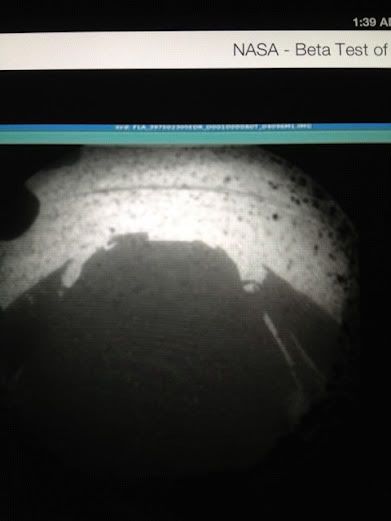**2.54am** Here is video of the descent and landing, and the initial celebration.
**1.48am** Mars Science Lab/Curiosity Rover has safely landed on Mars and a few images have already been transmitted back.
Here is one that shows the shadow of Curiosity on Mars:


The most advanced robot ever sent to another world is set to land on Aug. 5, 2012 (PDT). Will you be watching? (See video of the launch)
Mars Science Laboratory will deliver the Curiosity rover to the surface of Mars at approximately 10:31 p.m. PDT on Aug. 5 (1:31 a.m. EDT and 5:31 a.m. UTC on Aug. 6). Curiosity, carrying laboratory instruments to analyze samples of rocks, soil and atmosphere, will investigate whether Mars has ever offered environmental conditions favorable for microbial life.
NASA TV will broadcast live from mission control at NASA’s Jet Propulsion Laboratory in Pasadena, Calif., during Curiosity’s critical entry, descent and landing phase.
Here is a short video explaining what the seven minutes of terror is about:
You can watch the NASA video stream (embedded immediately below) of the event, which is scheduled to start at 11:30pm Eastern Daylight Time, or you can watch it on a player that is further down on the page from SpaceVidCast. The landing (or crash) should take place at 1:31am:
NASA TV
With Mars looming ever larger in front of it, NASA's Mars Science Laboratory spacecraft and its Curiosity rover are in the final stages of preparing for entry, descent and landing on the Red Planet at 10:31 p.m. PDT Aug. 5 (1:31 a.m. EDT Aug. 6). Curiosity remains in good health with all systems operating as expected. Today, the flight team uplinked and confirmed commands to make minor corrections to the spacecraft's navigation reference point parameters. This afternoon, as part of the onboard sequence of autonomous activities leading to the landing, catalyst bed heaters are being turned on to prepare the eight Mars Lander Engines that are part of MSL's descent propulsion system. As of 2:25 p.m. PDT (5:25 p.m. EDT), MSL was approximately 261,000 miles (420,039 kilometers) from Mars, closing in at a little more than 8,000 mph (about 3,600 meters per second).
Gale Crate Briefing
Gale Crater forms a large natural repository for a lot of Martian geologic history. This ancient impact scar has a diameter of about 150 kilometers (90 miles) and lies close to where the cratered highlands drop off onto the northern lowlands in Elysium. Based on its size and state of preservation, scientists estimate Gale formed 3.8 to 3.5 billion years ago.
What draws scientific interest most is a big mound of layered debris filling about a third of the crater's floor. Wrapping around the crater's central peak, visible at lower right in the image, the mound stands about 5.5 km (3.4 mi) higher than the northern crater floor and about 4.5 km (2.8 mi) above the southern floor. The mound's highest parts even rise somewhat higher than Gale's southern rim.
Read more at Mars Odyssey THEMIS
SpaceVidCast Live
The people at SpaceVidCast provide the world's best Citizen Journalist coverage of all things space.






























0 comments :
Post a Comment